#Ethnic African Heritage
Explore tagged Tumblr posts
Text

Beauty Skincare Model Skin Routine Cosmetics Makeup Photo Ethnic African "Embarking on Beauty's Journey: A Glimpse into the Skincare and Makeup Rituals of an Ethnic African Model."
#pretty girl#beautiful women#pretty woman#Timeless Beauty#Model's Beauty Routine#Ethnic African Heritage#Cosmetic Mastery#Flawless Makeup Application#Beauty Transformation Insights#Cultural Diversity in Skincare#Daily Beauty Regimen#Model's Makeup Proficiency#African Identity and Beauty
0 notes
Text
Normally, I don’t get into politics or talk about politicians without a meme like manner, but for the love of god
Please don’t refer to Kamala Harris as African American. She’s not that at all. She’s not part of our (descendants of slaves that were dropped off at 🇺🇸) ethnic group.
Her father is Jamaican. Her mother is Indian You are not going to throw her into our ethnic group and muddy up our accomplishments and definitions because of your ignorance. She’s literally Blasian. Blindian. A more accurate term would’ve been Caribbean-American or Jamaican-American if you still wanted to acknowledge her half-Blackness. Or since this is an actual term for her ancestry in the Caribbean, say she’s a Dougla.
I get it, a woman of color is running for president. You’re excited. But what we’re not going to do is start throwing people into my ethnic group just because they share a drop of Blackness, even though they’re from a different part of the Diaspora.
@queen-shiba
#us politics#blackblr#kamala harris#not every black person in America is African American#there’s a whole diaspora of people here#don’t start throwing into my ethnic group just because they’re black or half black#it’s disrespectful#and it’s a borderline form of cultural and social ethnocide#soulaan#dougla#afro-Indian heritage
24 notes
·
View notes
Text
When I used to watch the early seasons of the FT anime , something about Jellal always struck me as distinct about his features. His eyes always looked more prominent than the rest of the guys and I have cracked why.
My guy is wearing Kohl/Surma/Kajal.

Like LOOK at how defined his eyes are compared to another character , you can’t tell me the guy isn’t putting something on. Especially when no other guy or girl character has such defined eye looks (other than Macbeth but it’s obvious he’s wearing eyeliner)
Yes people might say art style for the first season I can agree but look at the characters and then Jellal and tell me if there isn’t something more there.





Look at the guys here , they have dark lashlines but nowhere NEAR as dark and prominent as Jellal.


Even compared to girls from the first season Jellal has a darker and more thicker lash line compared to them.

Look at the difference between him and Erza side by side! He definitely has a more defined lash line! And look compared to FT girls eyes, when it is the convention of girls usually having the darker lashline in anime.
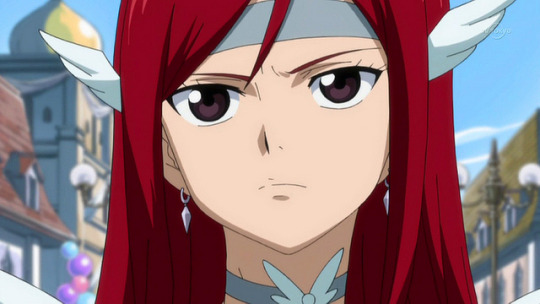



And then Jellal


There's a clear distinction! His is not just more defined and connected compared to men in FT but also females too!
The reason I have come to the conclusion of Kohl/Kajal/Surma is because I HC Jellal with Arab heritage (or whatever would be the equivalent in earthland-) due to his name Jellal (which is basically another spelling of Jalal) and Kohl is known to be used by the men in the Arab culture to beautify them. And also Kohl is used by people in Arabia/India/Egypt due to its medicinal properties for retaining eye health and improving vision!
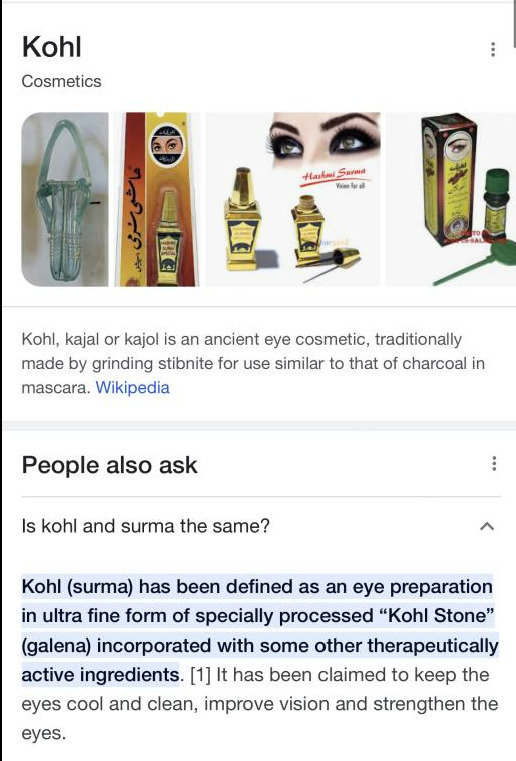
Also what differentiates for my thinking that Jellal is not using normal eyeliner but Kohl/Surma/Kajal is because of the way it is applied. Other eyeliners can go on the outer eye but Kohl/Surma is traditionally applied always in the inner corners of the eyes, just like Jellal has (in season 1)



(As you can see the girl in the photo above has her eyes lined like Jellal using Kohl/Surma/Kajal)

Considering Jellal’s magic , I can imagine there is a huge priority on his vision due to the speeds he travels at when casting, so it makes sense for him to use such a thing to help him in battle or aid in beating the consequences of using his magic so his sight isn’t compromised and remains strong!
Also because Jellal's magic revolves around using stars/light , this medicinal cosmetic has also been used to protect against the glare of light which would also come to help for Jellal in battle!

So what is the take away from this post? I put way too much thought trying to prove a HC I have had from young but found out it actually adds up now looking at the facts. You guys can tell me if i'm reaching or not with this after seeing the evidence and argument presented.

Also season 1 Jellal Fernandes is an ethnic king and we stan he never forgot his roots. <3

#jellal fernandes#jellal fernandez#ft jellal#Jellal#fairy tail jellal#fairy tail#hc#fairy tail headcanons#heritage hc#ethnicity hc#arabian jellal#egyptian jellal#indian jellal#south asian Jellal#north african Jellal#Jellal has to have ONE of these heritages named above (or maybe mutiple idk??)#ethnic jellal#POC Jellal#kohl#surma#eye kajal#kohl/kajal/surma on anime characters#I put way too much thought into this but it adds up#my first hc post lol#yamishika's hcs
90 notes
·
View notes
Text
Exploring the Rich History of the Soninke People in Mali
Unveiling the Fascinating Soninke People of West Africa The Soninke people are an ethnic group with a rich cultural heritage deeply intertwined with the history of West Africa. This article delves into the fascinating world of the Soninke, exploring their origins, traditions, and the significant impact they had on the development of empires in the region. Whether you’re a history buff, an…

View On WordPress
#Cultural Diversity#Cultural Heritage#Cultural Influences#Cultural Tapestry#Ethnic Groups#Ghana Empire#Historical Significance#inclusivity#Interpretation Services#Language Access#Language Services#LanguageXS#Mande Language#Soninke Diaspora#Soninke Language#Soninke People#West Africa#West African Traditions
2 notes
·
View notes
Text
Vintage African Regal Princess Extra-Large Silver-Tone Pendant
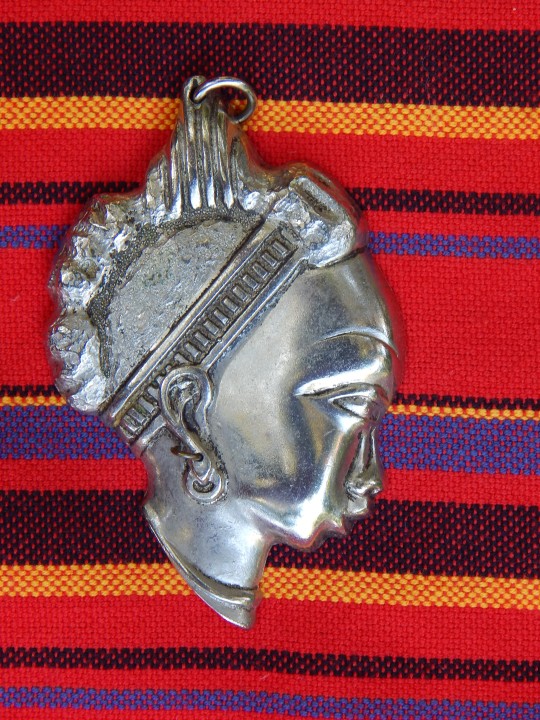
This absolutely stunning and massive, silver-tone African princess profile pendant is a knockout! The artisan who sculpted or cast this timeless pendant has an obvious eye toward beauty in its sincerest and purest form and perhaps intended the representation of this glamourous woman to record her picture-perfect, expressive side-view for all eternity. She "wears" a traditional headdress and a single “hoop” earring hangs from her earlobe.
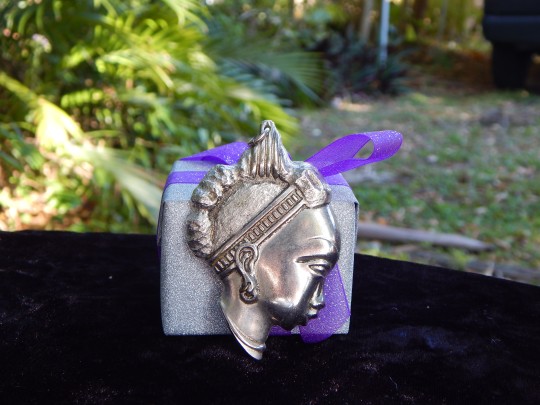
This pendant is a bold and striking conversation starter as is hangs from your favorite necklace or chain!
#african jewelry#african beauty#african princess#african queen#nubian princess#nubian queen#africa#african#african pride#african heritage#african culture#afrocentric#african diaspora#african american#african american jewelry#afropunk#samburu#maasai#turkana#kenya#tanzania#namibia#ethnic jewelry
4 notes
·
View notes
Text

My latest Ancestry DNA results.
1 note
·
View note
Text
Ultimate Travel Guide to Cameroon
Nestled in the heart of Central Africa, Cameroon is a vibrant country that offers tourists a diverse experience. Known as “Africa in miniature,” Cameroon has everything from lush rainforests, beautiful beaches, and active volcanoes to savannas, traditional villages, and cosmopolitan cities. It is rich in culture, history, and natural beauty, making it a must-visit destination for any traveler. A…
#African Cup of Nations 2024 Cameroon#African Heritage in Cameroon#Best Places to Visit in Cameroon#Best Restaurants in Cameroon#Business Opportunities in Cameroon#Cameroon Cultural Tours#Cameroon Culture and Traditions#Cameroon Economy 2024#Cameroon Football Team#Cameroon History#Cameroon Independence Day#Cameroon Music and Dance#Cameroon National Parks#Cameroon People and Traditions#Cameroon Safari Tours#Cameroon Startup Scene#Cameroon Street Food#Cameroon Tourism#Cameroon Travel Guide#Cameroon Wildlife#Cameroon’s Ethnic Groups#Cameroonian Cuisine#Cameroonian Festivals#Cameroonian Languages#Discover Cameroon#Douala Travel Guide#Eco-Tourism in Cameroon#Explore Yaoundé#Hiking in Cameroon#Investing in Cameroon
0 notes
Text
ID: screenshot of 3 pages of text which reads:
Illusion in Assimilation:
My sense of alienation during my childhood turned upon this axis: I did not look Moroccan, and so I was "lucky." I did look Ashkenazi, and so I was "very lucky." Trapped between who I was and who people thought I was, my world view crystallized according to a clear dichotomy of good and bad, based on origin.
When I was ten, my father was promoted at work, and my parents moved to Jerusalem. This move gave me the opportunity to open a new page in my life: Since no one knew me, I could invent a new self-image and escape from bring one of the "ugly Moroccans." I told new friends that I was born in France. From that rime on, I spent my time constructing and protecting the child I wanted to be—the French child. To be convincing, I eliminated my distinctive Arabic accent when pronouncing the words het and ‘ayin, and I trained myself to adopt the typical Ashkenazi pronunciations, chet and ayin. I never invited any of my friends home, so as not to risk having them discover my real life. I even forbade my mother from speaking Arabic in the street.
Soon, even I began to believe my own deceptive tales, and little by little I constructed a desirable identity for myself. I asked my parents about French words, since they had studied at the Alliance Israelite French colonial school in Morocco. I asked them about French history and culture, and long before the general history classes began in school, my mother had taught me about Zola, Hugo, Les Misenabkz Rousseau and the Revolution, Napoleon and his battles, and General Lyotee.
I incorporated all this information into the identity I was weaving, and I added biographic details meant to ensure my acceptance in class. For example, I claimed that I studied fine arts—which was easy, since everyone studied fine arts. Later, I added that I studied dance. Everyone believed this claim, as well, since I had good physical coordination and loved athletics. Once, during a youth training course, I was asked to perform a dance piece. I made something up, which later I found out was called "improvisation," and it went over great.
As the two realities of home and school grew more and more distant from each other, I developed my tales and cushioned my world with soft, fluffy, and happy imaginative thoughts. I outdid myself when I bragged to my teacher in vocational high school that I had been chosen to participate in the Habima Youth. Habima is the Israeli National Theater Company. Habima Youth was an imaginary, nonexistent organization, which I said was meant to promote talented young actors. The teacher believed me and permitted me to leave class early every Tuesday.
It is clear now that the common denominator of all my tales, whether I was conscious of it or not, was Ashkenazi culture. I hated the real me. Me, the Moroccan, the non-French, the immigrant who didn't participate in enrichment programs like the other kids, who did no more than her very annoying school work. I had to read and memorize entire books on the Jewish people throughout the "world," meaning throughout Eastern Europe. I had to read about my supposed ancestors in the shtetl, about the "family of fighters" who broke through to besieged Jerusalem, all of whom were European; and about the Choma u Migdal, the wall and tower of the pioneer kibbutzim, founded by European Jews. I never found the real me in these books.
In despair, I stopped studying, and I became more certain that I should hold onto that imaginative French girl. Mikraot Yisrael (Roots of Israel) and likewise Historia shel Am Yisrael (The History of Israel), obligatory elementary school texts on Israeli history and literature, provided background for my invented European girl, and they reinforced my belief that the other girl, the real me, did not deserve to exist.
When I finally found texts written about the real me, I discovered that I was Mizrahi, described as dirty, poor, contagious with infectious diseases, spiritually impotent, lacking moral capacities, ignorant, violent, and lazy. At best, my parents and I were described as "having fallen into an historical coma." At worst, we were accused of bringing about the cultural demise of the yishuv--the Jewish Settlement-due to our inferiority complex as tribes and edot. Edot is the term used to describe something just short of "ethnicities," lest it he known that Jews do not constitute a singular "ethnic" group., For Ashkenazim, "Jewish unity" seems predicated on a notion of sameness. The idea of Jews being a multiracial, multiethnic people somehow threatens Ashkenazi leadership.
After reading about the despicable qualities of Mizrahim, I had enough convincing evidence to justify the extermination of my hated Moroccan self. Even history said she was bad, and who wanted to be primitive and dirty?
I worked hard to acquire Ashkenazi knowledge and invested all my energy in it. I did it, however, as a thief in the night. I looked out of the corner of my eye to see what the other kids ate, how they played, and what they wore. I listened to their conversations about cello lessons, messy rooms, and the punishments their mothers gave. I visited their homes and checked to see how their rooms were furnished. I saw their little radios and observed them listening to Hamasch Oleh, "high" culture theatrical broadcast. I aspired to be like them, speak like them, be accepted by them.
End of ID.
And people keep trying to justify Israel's existence on the basis that it is somehow a safe place for the preservation of Jewish people and their culture and not only is that an awful argument for establishing a Settler Colonist Apartheid State but it's not even true. Like the state is politically and economically dominated by Ashkenazi Jews from Northern Europe and their descendants. While not as severely mistreated as Palestinians, there is still a significant disparity between the European and Non-European Jews in terms of income and education. Non-European Jews are still regularly subject to interpersonal bigotry (hell earlier this year there was a news story about a viral video where Ashkenazi girls in a Purim made a skit mocking the Mizrahi) and Israel government policies towards non-Ashkenazi migrants have done severe damage to their social structure and cultural traditions. Not to mention the fact that the whole reason why many Mizrahi migrated in the first place was to escape the violence caused by European Jews committing atrocities in their name, tearing communities apart as neighbours that had peacefully co-existed for centuries found themselves on opposite sides of this new ethno-religious conflict
There have even been attempts in Israeli history at the forceful assimilation or even biological reduction of non-European Jews; the kidnapping and adoption of Yemeni Jewish children in the 1950s is significant example of the former while the forced contraception of Beta Israeli (Ethiopean Jewish migrants) with the explicit intention of reducing their population's birth rate is an example of the latter. There's also very clear favouritism when it comes to recent converts; white Afrikaner converts are given the right of Aliyah while Nigerian Igbos are not. Like the fact of the matter is that Israel's fundamental nature is as a European Settler Colony, incredibly racist not only towards the indigenous Palestinians but the many Non-European Jews it claims to represent. It's an outpost of Western Imperialism, not a haven for the Jewish people. If it was ever meant to be the latter than it has failed miserably
#Described#To read#Israel#Ethnicity#White supremacy#Racism#The Flying Camel: Essays on Identity by Women of North African and Middle Eastern Jewish Heritage#specifically Henriette Dahan Kalev#Illusion in Assimilation#The flying camel
6K notes
·
View notes
Text
Since supporting the springboks it has reminded me that I spell Opa wrong (it's spelled Oupa in Afrikaans) and I'm still not entirely sure what to do with that information. I only ever spelled it Opa in his lifetime so it feels wrong to change it posthumously even though I know that's how it was originally spelled (there's an old picture of him with my cousins where it is spelled Oupa. They're the ones who changed the spelling I think because they're Dutch). my cousins are a lot older than me and I think by the time i came along he'd accepted the Opa spelling because I don't remember ever seeing it spelled Oupa in cards. But at the same time if for some unknown reason I'm in a comment section and I'm like oh yeah I support the springboks because of my Opa I'm going to get judged by a lot of Afrikaners for spelling it wrong
#whats really ironic is that my opa isn't even afrikaner he's british south african i mean he has some afrikaner heritage and he spoke it a#little (apparently my cousin went through a phase of refusing to speak English when she was little so he spoke afrikaans to her) but he was#culturally and for the most part ethnically british but apparently it wasn't (isn't?) uncommon for english speaking south africans to call#their grandparents ouma and oupa despite the ethnic tensions certainly in my opa's time although apparently he had one grandmother who made#him call her granny. funnily enough i think it was the grandmother with Afrikaner heritage as opposed to his fully english grandmother.#compensating i guess
0 notes
Text
The Empowering Impact of African Fashion Brands on Local Artisans
Investigate how the rise of African fashion brands has empowered local artisans by providing them with opportunities, recognition, and sustainable livelihoods.

Fully backed by customers, powerhouses, and the design community, African style is set to cement its place as a critical force in the worldwide design scene into the indefinite future.
African design has encountered a noteworthy resurgence on the worldwide stage, catching the attention of style lovers and industry pioneers alike. The mainland’s rich social legacy and imaginative variety have prepared nearby craftsmen to change their manifestations into worldwide design symbols.
The ascent of African fashion brands from neighborhood craftsmen to worldwide symbols is a demonstration of the force of imagination, culture, and social cognizance. These brands have opposed generalizations, enabled nearby networks, and carried Africa’s rich legacy to the cutting edge of the style business.
#African fashion brands#African clothing brands#Afrocentric fashion#African-inspired fashion#Ethnic fashion brands#African couture#African designer labels#Contemporary African fashion#Afro-fashion designers#African textiles and fashion#African prints clothing#Traditional African attire brands#Global African fashion icons#Authentic African fashion#African fashion industry#African fashion trends#Afro-modern fashion#African heritage in fashion#Ethical African fashion brands#African fashion culture
1 note
·
View note
Text

Beauty Skincare Model Skin Routine Cosmetics Makeup Photo Ethnic African
Unveiling Ethereal Beauty: Exploring the Skincare and Makeup Rituals of an Ethnic African Model."
#Timeless Elegance#Model's Beauty Journey#Ethnic African Heritage#Cosmetic Mastery#Flawless Makeup Techniques#Beauty Transformation Insights#Cultural Diversity in Beauty#Daily Skincare Regimen#Model's Makeup Expertise#African Ethnicity and Beauty#pretty girl#beautiful women#pretty woman
0 notes
Text

PLS THIS IS SO REAL. my last name is not even that hard to pronounce and ppl will just absolutely butcher it. add “avishai” before it and they blue screen.
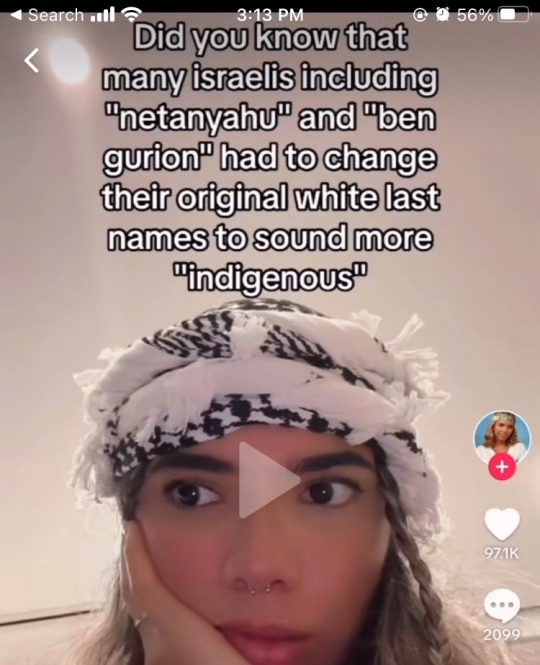
Are you fucking for real with this? Y’all have really been whipped into such an antisemitic frenzy like.
“Members of a non-European ethnic group were displaced from their ancestral land and forced to take European names in Western nations hundreds of years ago. Now they’re changing their names back to names that have historical precedent in their native languages. (Black people)” is universally accepted as a good thing by liberals / leftists / anti-racists. But for some reason
“Members of a non-European ethnic group were displaced from their ancestral land and forced to take European names in Western nations hundreds of years ago. Now they’re changing their names back to names that have historical precedent in their native languages. (Jewish people)” is considered a horrifyingly evil colonial tactic?
Most Jews living in European diaspora didn’t have surnames at all until a handful of centuries ago. Sephardim were forced to take on Spanish surnames to avoid being killed by the Inquisition following the Alhambra Decree in 1492. Ashkenazim were forced to adopt Germanic and Eastern European names in different nations at different times between the 1780s and the 1850s. Both Ben Gurion and Netanyahu’s “white” names were forced upon them by local Prussian, Russian, or Austro-Hungarian officials less than three hundred years ago. Adopting Hebrew-or-Yiddish-derived last names were banned by most of these laws. When Jewish families left the nations that had forced them to adopt white Germanic last names, they adopted indigenous Jewish last names instead.
David Ben Gurion was born David Güre. He literally just added a Hebrew patronymic prefix to his father’s last name. Meanwhile Mohammed Ali was born Cassius Marcellus Clay. Amiri Baraka was born Everett Leroy Jones. Kareem Abdul-Jabbar was born Ferdinand Lewis Alcindor. When you commend black people for shaking off names that were forced upon them by Europeans three hundred years ago, but vilify Jewish people for doing the exact same thing, you’re antisemitic. There’s no other way around it.
#also the same kind of person who will insist ‘ITALIANS R WHITE’ as if non white italians don’t exist#my nonna was visibly non white especially when she was younger#her entire family was bc they were sicilian— had a mix of jewish north african and other west asian heritage#just bc u can’t comprehend racial diversity in european ethnic groups bc u have been brainwashed by white supremacy doesn’t mean#doesn’t mean it doesn’t exist
4K notes
·
View notes
Note
- Sephardi Jew here. Thank you for your posts concerning Palestinian Jews. Jewish people who are ethnically North African/West Asian are consistently left out of these conversations. Make no mistake - the word "Mizrahi" was invented by Israel to literally strip Palestinian Jews of their identities during the beginning of the occupation. The message was to either assimilate with the Ashkenazi, or die as a Palestinian. The entire reason people struggle to find resources about the history of Palestinian Jews is because it has been purposefully obscured by the occupation. While I am not Palestinian, (that I know of, the other funny thing, diaspora members of the Sephari community often have trouble pinning down our exact heritage, I'll let you guess why) my ethnic background is Moroccan, Libyan, Maltese. Jews from the Iberian Peninsula and Mediterranean Sea have always been here, will continue to be here. You don't have to answer this publicly or anything, btw, I just really try to reach out to people who elevate the voices of the Jewish people from this area of the world. It profoundly touches my heart.
of course, no need to thank me. an aspect of the occupation is a lot of palestinian jews have been erased from palestinian history which is pretty heartbreaking as someone who makes it their lifegoal to preserve palestinian cultural heritage and spread it to people.
it is really difficult finding resources on jewish history in SWANA before it was touched by the occupation despite it being a fundamental part of swana history.... and part of that is from european colonialism and the other part of it is collaboration with european colonialists and swana governments.
if anyone has sources on swana jewish history (i know of hadar cohen and avi shlaim rn), please do let me know so i can look into it!!
3K notes
·
View notes
Text
M.I.A. - Paper Planes 2008
"Paper Planes" is a song by British hip hop artist M.I.A. It was released on 11 February 2008 as the third single from her second studio album, Kala (2007). It samples English rockband the Clash's 1982 song "Straight to Hell", leading to its members being credited as co-writers. A downtempo alternative hip hop, pop track combining African folk music elements, the song has a less dance-oriented sound compared to other songs on the album. Its lyrics, inspired by M.I.A.'s own problems obtaining a visa to work in the USA, satirise American perceptions of immigrants from war-torn countries, and said that the issue was probably "them thinking that I might to [sic] fly a plane into the Trade Center".
M.I.A. had wanted to work with American producer Timbaland for the album Kala, but her application for a long-term US work visa was rejected. This was allegedly due to her family's connection to the Tamil guerrillas, commonly known as the Tamil Tigers, a claim M.I.A. denied. Her visa problems were also attributed to her criticism of the Sri Lankan government's discrimination and alleged atrocities committed against the Tamils, with whom M.I.A. shares an ethnic and cultural heritage. She expressed this on her politicised debut album Arular. The unexpected success of "Paper Planes" paralleled M.I.A.'s condemnations of the Sri Lankan government's war crimes against the Tamils, generating accusations that she supported terrorism.
The song received widespread acclaim from contemporary critics, who complimented its musical direction and the subversive, unconventional subject matter. It won awards from the Canadian Independent Music Awards and the American Society of Composers, Authors and Publishers (ASCAP), and earned a Grammy nomination for Record of the Year. The song has received praise in publications such as NME, Pitchfork and Rolling Stone, each naming it among either the best songs of the 2000s decade or of all time. The review aggregator Acclaimed Music reports it as the second-most acclaimed song of the 21st century.
"Paper Planes" was used in the theatrical trailer for the 2008 stoner comedy Pineapple Express, directed by David Gordon Green, which catapulted the song to mainstream success in the US. "Paper Planes" and the DFA remix appear on the soundtrack to Danny Boyle's drama Slumdog Millionaire, released in 2008. The video game Far Cry 3 (2012) begins with "Paper Planes" used in the opening cinematic sequence.
"Paper Planes" received a total of 68,9% yes votes!
youtube
1K notes
·
View notes
Text
Exploring the Rich Culture of the Ibo People in Nigeria: A Comprehensive Guide to One of the Largest Single Ethnic Groups
Disclosing the Rich Tapestry of Igbo Heritage: An in-depth examination of Nigeria’s Dynamic Culture Nigeria’s Igbo people are an enthralling ethnic group with a rich history, colorful customs, and a significant influence on African culture. This essay explores the fundamentals of Igbo culture, looking at its traditions, historical foundations, and remarkable resilience in the face of adversity.…

View On WordPress
#African heritage#Ibo people#Igbo culture#Igbo diaspora#Igbo history#Igbo language#Igbo traditions#LanguageXS#Nigerian Civil War#Nigerian ethnic groups
0 notes
Text
Vintage African Royal Princesses Sterling Silver Clip-On Earrings by Candida - Joe Calafato South Africa

Stunning sterling silver earrings by world-renowned South African jewelry artist, Joe Calafato! Rich with vivid imagery, Calafato’s timeless African iconography and aesthetic appreciation of African expressions are once again present in this gorgeous pair of earrings that wonderfully capture the nobility of African female beauty.
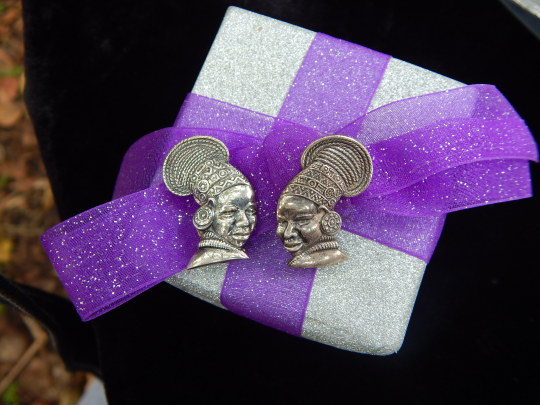
These earrings are a masterfully designed portrayal of two Nubian princesses wearing a traditional majestic headdress with imperial expressions upon their faces. These beautiful earrings have a rich, natural patina and are hallmarked, are lightweight, and cling very gently on the ear with hinged clips. The clip-on earrings have an endearing and enduring sentiment for one with a keen eye for African beauty and art!
#African jewelry#African art#African beauty#African princess#African queen#Nubian princess#Nubian queen#South Africa#South African jewelry#South African#Joe Calafato#Calafato#vintage jewelry#vintage earrings#ethnic jewelry#Black pride#Afrocentric#Nigerian princess#African wedding#African heritage#African culture#African diaspora#Senegalese#etsy
1 note
·
View note